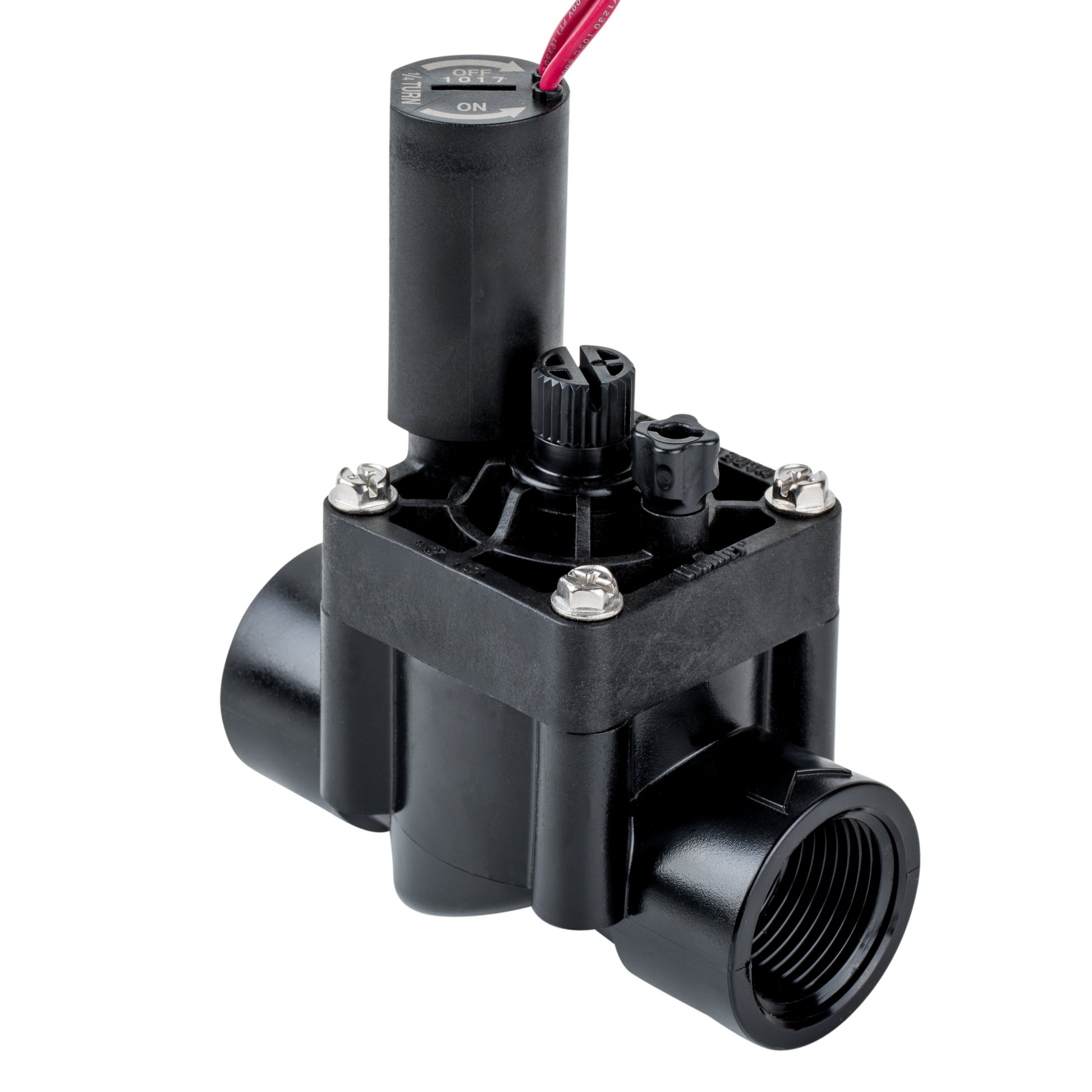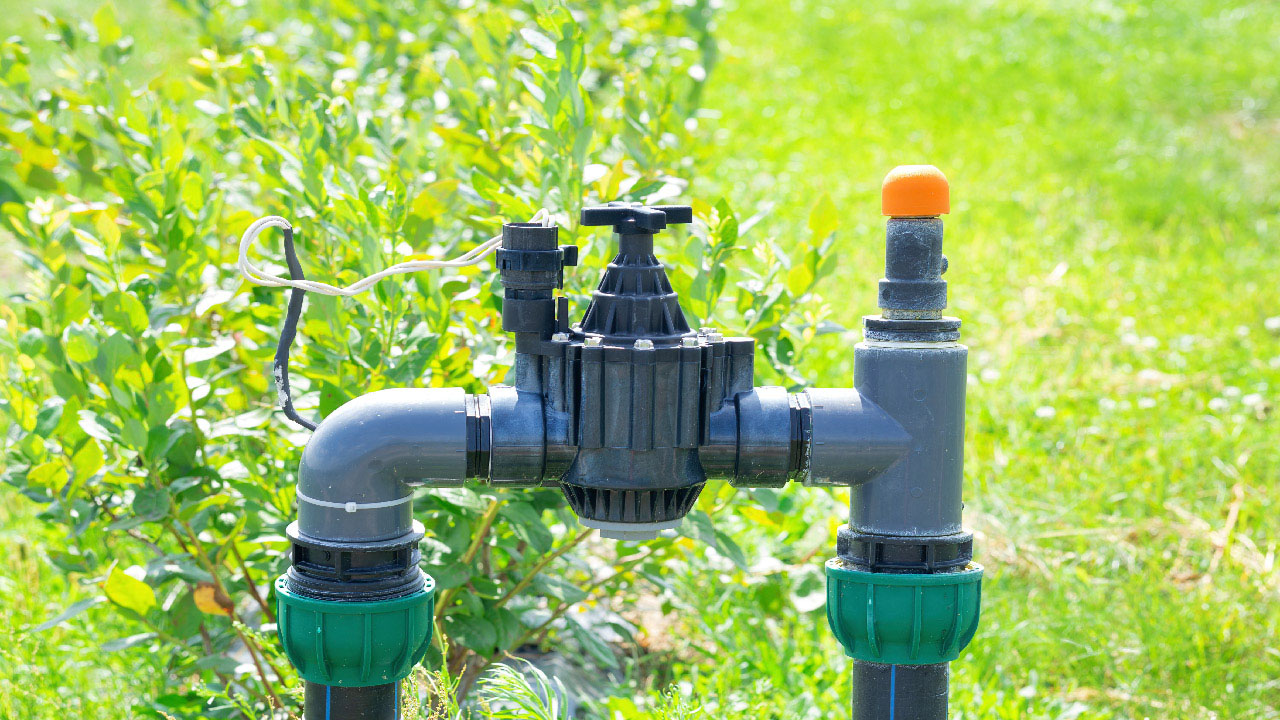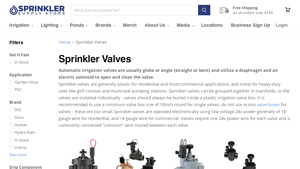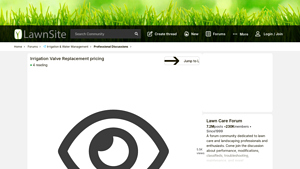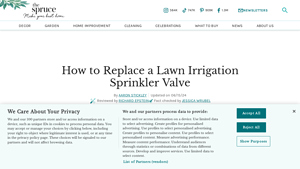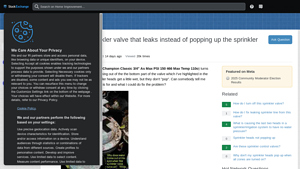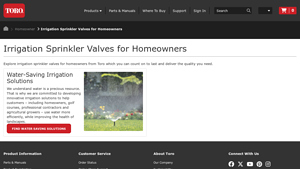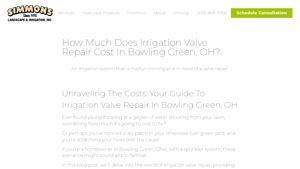Introduction: Navigating the Global Market for irrigation valve replacement
Navigating the complexities of sourcing irrigation valve replacement can be a daunting challenge for B2B buyers, especially in diverse markets across Africa, South America, the Middle East, and Europe. The need for reliable, efficient, and cost-effective irrigation solutions is paramount as businesses strive to enhance agricultural productivity and water management systems. This guide aims to equip international buyers with the essential knowledge to make informed purchasing decisions regarding irrigation valve replacement, covering a broad spectrum of topics from types and applications to supplier vetting and cost considerations.
Within these pages, you will find an extensive examination of various irrigation valve types, including automatic, manual, and specialty valves, alongside insights into their specific applications in different climatic and agricultural contexts. We delve into best practices for selecting reputable suppliers, ensuring that you can confidently navigate the global marketplace while mitigating risks associated with quality and service reliability. Additionally, the guide addresses cost factors, providing a framework to evaluate total cost of ownership, which is critical in optimizing budget allocations for irrigation systems.
By leveraging the insights presented in this comprehensive guide, B2B buyers can streamline their procurement processes, enhance operational efficiencies, and ultimately, contribute to sustainable agricultural practices in their respective regions. Whether you are looking to upgrade existing systems or replace faulty components, this resource is designed to empower you with the tools needed for strategic decision-making in the irrigation valve replacement landscape.
Understanding irrigation valve replacement Types and Variations
| Type Name | Key Distinguishing Features | Primary B2B Applications | Brief Pros & Cons for Buyers |
|---|---|---|---|
| Electric Solenoid Valves | Operated by low voltage, typically 24V; automated control | Residential and commercial irrigation systems | Pros: Easy automation, precise control; Cons: Requires electrical installation and maintenance. |
| Anti-Siphon Valves | Prevents backflow; typically includes a built-in vacuum breaker | Agricultural and landscape irrigation | Pros: Protects water supply; Cons: More complex installation compared to standard valves. |
| Manual Control Valves | Requires physical operation; often used in smaller systems | Small farms, gardens, and DIY projects | Pros: Simple and cost-effective; Cons: Labor-intensive, less convenient for large systems. |
| Pressure Regulating Valves | Maintains consistent water pressure; prevents over-pressurization | High-pressure irrigation systems | Pros: Protects equipment from damage; Cons: Can be more expensive and complex to install. |
| Flow Control Valves | Adjustable flow rates; helps manage water usage | Commercial landscaping and agricultural use | Pros: Enhances efficiency and conservation; Cons: May require calibration and monitoring. |
What Are Electric Solenoid Valves and Their Applications?
Electric solenoid valves are integral to modern irrigation systems, operating on low voltage, typically 24V. They allow for automated control of water flow, making them ideal for both residential and commercial applications. B2B buyers should consider the ease of integration into existing systems, as well as the need for electrical infrastructure. While these valves provide precise control and convenience, they do require regular maintenance to ensure optimal functionality.
Why Choose Anti-Siphon Valves for Irrigation Systems?
Anti-siphon valves are designed to prevent backflow, which is crucial in maintaining water quality in irrigation systems. These valves often come with built-in vacuum breakers, making them suitable for agricultural and landscape irrigation applications. When purchasing, B2B buyers should assess the complexity of installation and ensure compatibility with existing systems. While they offer significant protection for water supplies, their installation can be more intricate than standard valves, potentially increasing labor costs.
How Do Manual Control Valves Fit Into Smaller Systems?
Manual control valves are straightforward devices that require physical operation to regulate water flow. They are commonly used in smaller irrigation systems, such as those found in gardens or small farms. B2B buyers appreciate their simplicity and cost-effectiveness; however, they should be aware that these valves demand more labor to operate, especially in larger setups. Manual valves are ideal for those looking for a low-tech solution without the need for extensive automation.
What Role Do Pressure Regulating Valves Play in Irrigation?
Pressure regulating valves are crucial for systems exposed to high water pressure, as they maintain consistent pressure levels to prevent damage to irrigation equipment. These valves are particularly beneficial in commercial settings where over-pressurization could lead to costly repairs. B2B buyers should evaluate the long-term savings on equipment maintenance against the initial investment and installation costs. While they enhance system longevity and reliability, the complexity of installation can be a drawback.
Why Are Flow Control Valves Important for Water Management?
Flow control valves allow users to adjust the flow rate of water, promoting efficient water usage in commercial landscaping and agricultural operations. These valves help optimize water conservation efforts, making them highly relevant for businesses focused on sustainability. When considering a purchase, B2B buyers should think about the need for regular calibration and monitoring to ensure efficiency. Although they offer significant benefits in terms of resource management, they can also involve higher upfront costs and ongoing maintenance considerations.
Key Industrial Applications of irrigation valve replacement
| Industry/Sector | Specific Application of Irrigation Valve Replacement | Value/Benefit for the Business | Key Sourcing Considerations for this Application |
|---|---|---|---|
| Agriculture | Replacement of valves in large-scale irrigation systems | Enhances water efficiency and crop yield | Compatibility with existing systems and local climate conditions |
| Landscaping and Horticulture | Upgrading valves in commercial landscaping projects | Reduces maintenance costs and improves water management | Durability against environmental factors and ease of installation |
| Golf Course Management | Replacement of valves in irrigation systems for greens | Ensures consistent turf health and aesthetics | Quality of materials and brand reputation for reliability |
| Municipal Water Management | Upgrading valves in public irrigation systems | Promotes sustainable water usage and reduces waste | Compliance with local regulations and availability of parts |
| Industrial Food Production | Replacement in irrigation systems for agricultural processing | Increases operational efficiency and product quality | Specific requirements for food safety and material certifications |
How is ‘Irrigation Valve Replacement’ Used in Agriculture?
In the agriculture sector, irrigation valve replacement is crucial for maintaining large-scale irrigation systems. These systems often rely on various valve types to manage water flow efficiently. Replacing worn or malfunctioning valves can significantly enhance water efficiency and crop yield, ensuring that crops receive the right amount of water at the right time. Buyers should consider compatibility with existing systems and the local climate conditions to select appropriate valve types that can withstand regional variations.
What are the Benefits in Landscaping and Horticulture?
In commercial landscaping projects, upgrading irrigation valves can lead to substantial reductions in maintenance costs while improving overall water management. Efficient valve systems help maintain optimal moisture levels for plants, contributing to healthier landscapes. For B2B buyers, sourcing durable valves that can resist environmental stressors, such as UV exposure and extreme temperatures, is essential. Ease of installation is also a key consideration, as it minimizes downtime during upgrades.
Why is Valve Replacement Important for Golf Course Management?
Golf course management relies heavily on effective irrigation systems to ensure the health and aesthetics of the turf. Regular replacement of irrigation valves is necessary to maintain consistent water distribution across greens and fairways. This practice not only promotes turf health but also enhances the overall playing experience. When sourcing valves, golf course managers should prioritize high-quality materials and reputable brands known for their reliability, as these factors directly influence the longevity and performance of the irrigation system.
How Does Municipal Water Management Benefit from Valve Replacement?
Municipal water management systems often incorporate extensive irrigation networks for parks, recreational areas, and public gardens. Upgrading valves in these systems is essential for promoting sustainable water usage and reducing waste. Municipalities must ensure compliance with local regulations regarding water management and conservation. Therefore, buyers should focus on sourcing valves that meet these standards and can be easily integrated into existing infrastructure, ensuring minimal disruption during the replacement process.
What Role Does Valve Replacement Play in Industrial Food Production?
In industrial food production, irrigation systems are critical for agricultural processing and maintaining crop quality. Regular valve replacement ensures that these systems operate efficiently, directly impacting operational efficiency and the quality of the final product. Buyers in this sector must consider specific requirements related to food safety, such as certifications for materials used in valve construction. This ensures that the irrigation system meets health regulations while also maintaining productivity levels.
3 Common User Pain Points for ‘irrigation valve replacement’ & Their Solutions
Scenario 1: Misalignment in Valve Specifications During Procurement
The Problem: One common challenge faced by B2B buyers in irrigation valve replacement is misalignment in valve specifications. This often occurs when buyers attempt to source valves without fully understanding the compatibility with existing systems. For instance, a buyer in Africa may require specific flow rates and pressure tolerances for their agricultural operations, but purchasing generic or incompatible valves can lead to system inefficiencies, water wastage, and increased operational costs.
The Solution: To mitigate this issue, buyers should start by conducting a comprehensive assessment of their existing irrigation systems. Documenting key specifications such as valve size, pressure ratings, and flow requirements is crucial. When sourcing replacement valves, always refer to this data to ensure compatibility. It is advisable to work closely with suppliers who can provide technical support and detailed product specifications, including installation guidelines and compatibility charts. Additionally, investing in high-quality valves from reputable manufacturers can reduce the likelihood of future mismatches and ensure long-term reliability.
Scenario 2: Frequent Valve Failures and Maintenance Challenges
The Problem: Many buyers encounter frequent valve failures, leading to costly downtimes and maintenance challenges. In regions such as South America, where irrigation systems are critical for crop production, a malfunctioning valve can disrupt water supply and negatively impact yields. Buyers may struggle to identify the root cause of failures, whether due to poor-quality components, environmental factors, or improper installation.
The Solution: To address this pain point, it is essential to implement a proactive maintenance strategy. This includes regular inspections and timely replacements of components such as diaphragms and solenoids that are prone to wear and tear. Buyers should consider investing in repair kits that include all necessary parts, ensuring that maintenance can be performed quickly and efficiently. Training staff on proper installation techniques and maintenance practices can also prevent issues before they escalate. For those in harsh climates, selecting valves specifically designed for durability under extreme conditions can significantly enhance the longevity and reliability of the irrigation system.
Scenario 3: Inefficiencies in Water Management and Resource Allocation
The Problem: In regions with scarce water resources, inefficient irrigation systems due to poor valve performance can lead to significant wastage. Buyers in the Middle East, for instance, may face regulatory pressures to optimize water usage while still meeting agricultural demands. A malfunctioning valve can not only waste water but also create imbalances in distribution, resulting in some areas being over-irrigated while others suffer from drought conditions.
The Solution: To optimize water management, buyers should consider implementing smart irrigation technologies that integrate with modern valve systems. These technologies can include sensors and controllers that monitor soil moisture levels and adjust water flow accordingly. When replacing valves, opt for models that feature advanced flow control capabilities and are compatible with automation systems. Additionally, conducting a thorough analysis of the irrigation layout can help identify zones that require different watering schedules or valve specifications, ensuring that every drop of water is utilized effectively. Collaborating with irrigation specialists can provide valuable insights into the best practices and technologies available to enhance water efficiency.
Strategic Material Selection Guide for irrigation valve replacement
What Are the Key Materials for Irrigation Valve Replacement?
When selecting materials for irrigation valve replacement, it is crucial to consider their properties, advantages, disadvantages, and suitability for specific applications. Here, we analyze four common materials used in irrigation valves: plastic, brass, stainless steel, and ductile iron.
How Does Plastic Perform in Irrigation Valve Applications?
Plastic is one of the most widely used materials for irrigation valves, particularly in residential and light commercial applications. Key properties of plastic valves include lightweight construction, resistance to corrosion, and a pressure rating typically around 150 psi. The primary advantage of plastic valves is their cost-effectiveness, making them suitable for budget-conscious projects. However, they can be less durable than metal options, particularly in high-pressure or extreme temperature environments.
For international buyers, plastic valves must comply with regional standards such as ASTM in the U.S. or DIN in Europe. In regions with high UV exposure, such as parts of Africa and South America, UV-resistant plastics are preferred to ensure longevity.
What Are the Benefits of Brass in Irrigation Valves?
Brass is known for its durability and resistance to corrosion, making it an excellent choice for irrigation valves that require a longer lifespan. With a temperature rating of up to 200°F and a pressure rating of 300 psi, brass valves can handle more demanding applications. The main advantages of brass include its strength and resistance to wear, which is particularly beneficial in high-flow systems.
However, brass is generally more expensive than plastic and may not be as readily available in all regions. Buyers in the Middle East and Europe should ensure compliance with local standards, as brass can be subject to regulations concerning lead content.
Why Choose Stainless Steel for Irrigation Valve Replacement?
Stainless steel is often selected for its superior strength and corrosion resistance, especially in harsh environments. With a temperature rating exceeding 200°F and a pressure rating of 400 psi, stainless steel valves are suitable for high-performance applications. The primary advantage of stainless steel is its longevity and reliability, making it ideal for municipal and agricultural applications.
On the downside, stainless steel valves are typically more costly and may require specialized manufacturing processes, which can lead to longer lead times. International buyers should consider the availability of stainless steel valves and their compliance with standards like JIS in Japan or DIN in Germany.
What Role Does Ductile Iron Play in Irrigation Systems?
Ductile iron is a robust material often used in heavy-duty irrigation valves, particularly in municipal and industrial applications. Its high tensile strength and resistance to impact make it suitable for high-pressure systems, with pressure ratings often exceeding 300 psi. The key advantage of ductile iron is its durability and ability to withstand extreme conditions.
However, ductile iron is heavier and more expensive than other materials, which can impact installation costs. Buyers should also consider the need for protective coatings to prevent corrosion, especially in humid or saline environments. Compliance with international standards is essential, particularly in regions like Europe, where stringent regulations may apply.
Summary of Material Selection for Irrigation Valve Replacement
| Material | Typical Use Case for irrigation valve replacement | Key Advantage | Key Disadvantage/Limitation | Relative Cost (Low/Med/High) |
|---|---|---|---|---|
| Plastic | Residential and light commercial applications | Cost-effective and lightweight | Less durable under high pressure | Low |
| Brass | Agricultural and commercial applications | Strong and corrosion-resistant | Higher cost and potential lead issues | Medium |
| Stainless Steel | Municipal and high-performance applications | Long-lasting and reliable | Expensive and longer lead times | High |
| Ductile Iron | Heavy-duty municipal and industrial applications | Extremely durable and impact-resistant | Heavy and costly | High |
This guide provides a comprehensive overview of material options for irrigation valve replacement, enabling international B2B buyers to make informed decisions based on performance, cost, and compliance with regional standards.
In-depth Look: Manufacturing Processes and Quality Assurance for irrigation valve replacement
What Are the Key Stages in the Manufacturing Process of Irrigation Valve Replacement?
The manufacturing process of irrigation valve replacement components involves several critical stages, each essential for ensuring product quality and reliability. The main stages include material preparation, forming, assembly, and finishing.
Material Preparation: This initial stage involves sourcing high-quality raw materials, which can range from various plastics for residential applications to metals like brass and stainless steel for commercial-grade valves. Suppliers often conduct thorough inspections to ensure that materials meet specific industry standards. For instance, materials may be tested for resistance to corrosion, UV exposure, and temperature fluctuations, which are vital for components used in outdoor irrigation systems.
Forming: During the forming stage, raw materials are shaped into their respective components through processes such as injection molding for plastics or machining for metal parts. Advanced techniques like CNC machining are utilized to achieve precise tolerances, ensuring that parts fit together seamlessly. This stage may also involve creating intricate designs that enhance the functionality of the valves, such as anti-siphon features or flow control mechanisms.
Assembly: After forming, components are assembled into complete valve units. This process typically includes integrating diaphragms, solenoids, and other critical parts. Automated assembly lines are common, as they improve efficiency and reduce human error. However, some manufacturers still employ skilled workers for more complex assembly tasks, particularly those requiring fine-tuning or adjustments.
Finishing: The final stage involves applying protective coatings or finishes to enhance durability and aesthetic appeal. This may include anodizing metal components or applying UV-resistant coatings to plastic parts. The finishing process not only improves the product’s longevity but also prepares it for branding and packaging.
How Is Quality Assurance Integrated Into the Manufacturing Process?
Quality assurance (QA) is a vital aspect of the manufacturing process, ensuring that irrigation valve replacements meet the required standards of performance and reliability. Several international and industry-specific standards guide this process.
International Standards: Compliance with standards such as ISO 9001 is essential for manufacturers aiming to establish a robust quality management system. ISO 9001 ensures that processes are consistently monitored and improved, leading to higher product quality and customer satisfaction. Manufacturers may also adhere to specific certifications relevant to their market, such as CE marking in Europe or API standards for valves used in the petroleum industry.
Quality Checkpoints: Quality control checks are integrated throughout the manufacturing process. Key checkpoints include:
– Incoming Quality Control (IQC): Materials are inspected upon arrival to ensure they meet specified standards. This may involve testing for chemical composition, dimensional accuracy, and mechanical properties.
– In-Process Quality Control (IPQC): During the manufacturing process, operators conduct regular inspections to monitor critical dimensions and functional characteristics. This helps identify issues early in the production cycle, reducing waste and rework.
– Final Quality Control (FQC): Completed valves undergo rigorous testing before shipment. This may include pressure tests, flow tests, and functional testing to ensure that each unit operates as intended.
What Common Testing Methods Are Used for Irrigation Valves?
Testing is crucial for validating the performance and reliability of irrigation valves. Common testing methods include:
Hydraulic Testing: This method involves subjecting valves to high-pressure water to assess their ability to withstand operational conditions. It helps identify potential leaks or weaknesses in the valve structure.
Functional Testing: Valves are operated under controlled conditions to verify that they open and close correctly and maintain the desired flow rates. This testing is essential for ensuring that the valves perform as expected in real-world applications.
Durability Testing: Valves are subjected to accelerated aging tests, including exposure to extreme temperatures, UV light, and corrosive environments. This testing simulates long-term use and helps manufacturers assess the longevity of their products.
How Can B2B Buyers Verify Supplier Quality Control Processes?
For international B2B buyers, particularly those sourcing from regions like Africa, South America, the Middle East, and Europe, verifying a supplier’s quality control processes is critical for ensuring product reliability.
Supplier Audits: Conducting regular audits of suppliers allows buyers to assess compliance with quality standards and manufacturing practices. These audits can cover everything from material sourcing to production processes and quality control measures.
Quality Reports: Buyers should request quality reports that detail the results of inspections and tests conducted during the manufacturing process. These reports provide insight into the supplier’s commitment to quality and help identify any recurring issues.
Third-Party Inspections: Engaging independent third-party inspection agencies can provide an unbiased evaluation of a supplier’s manufacturing processes and quality assurance practices. This is particularly beneficial for buyers looking to ensure compliance with international standards.
What Are the Nuances of Quality Certification for International Buyers?
When sourcing irrigation valve replacements internationally, buyers must navigate various quality certification nuances that can affect their purchasing decisions.
Regional Standards: Different regions may have specific quality and safety standards. For instance, European buyers should be familiar with CE marking, while buyers in the U.S. may look for ANSI or ASTM certifications. Understanding these regional standards is crucial for ensuring compliance and avoiding potential legal issues.
Documentation Requirements: Buyers should be aware of the documentation required for importing products, which may include certificates of compliance, test reports, and material safety data sheets (MSDS). Proper documentation ensures smooth customs clearance and can prevent delays in the supply chain.
Supplier Relationships: Building strong relationships with suppliers can facilitate better communication regarding quality standards and practices. Suppliers who understand the specific needs and expectations of their B2B partners are often more willing to accommodate requests for customization or additional testing.
In conclusion, a thorough understanding of the manufacturing processes and quality assurance practices for irrigation valve replacements is essential for B2B buyers. By focusing on these areas, buyers can make informed decisions that lead to successful partnerships and high-quality products.
Practical Sourcing Guide: A Step-by-Step Checklist for ‘irrigation valve replacement’
Introduction
This guide serves as a practical checklist for B2B buyers looking to procure irrigation valve replacements. Whether you’re maintaining agricultural systems or landscaping operations, understanding the specific requirements and supplier capabilities is essential for ensuring optimal performance and longevity of your irrigation system.
Step 1: Define Your Technical Specifications
Before initiating the procurement process, it’s essential to clearly outline the technical specifications of the irrigation valves you require. This includes details such as valve type (e.g., automatic, manual, anti-siphon), material (plastic or metal), pressure ratings, and compatibility with existing systems. Defining these specifications upfront helps prevent compatibility issues and ensures that the valves meet your operational needs.
Step 2: Research Market Trends and Innovations
Stay informed about the latest trends and innovations in irrigation technology. Understanding advancements such as smart irrigation systems or energy-efficient valves can provide you with options that enhance efficiency and reduce long-term costs. Look for products that offer improved functionality, such as remote control capabilities or enhanced durability.
Step 3: Identify and Vet Potential Suppliers
Thoroughly research potential suppliers to ensure they meet your quality and service expectations. Request company profiles, product catalogs, and customer references. Pay attention to suppliers who demonstrate experience in your specific industry or region, as they are likely to understand your unique challenges and requirements.
Step 4: Verify Supplier Certifications and Compliance
It’s crucial to ensure that your suppliers hold relevant certifications and adhere to international standards. This may include ISO certifications or compliance with local regulations regarding irrigation products. Verified certifications not only reflect a supplier’s commitment to quality but also assure you that their products meet safety and performance standards.
Step 5: Evaluate Product Quality and Performance
Assess the quality and performance metrics of the valves you are considering. Look for detailed specifications, such as flow rates, pressure limits, and warranty information. Request samples if possible, and review performance data from other users to gauge reliability and efficiency under various conditions.
Step 6: Understand Pricing Structures and Payment Terms
Request detailed quotes from shortlisted suppliers, ensuring you understand their pricing structures and payment terms. Look for transparency in costs, including any additional fees for shipping or installation. Compare not only the prices but also the value offered, such as warranties or after-sales support, to make an informed decision.
Step 7: Plan for Installation and Maintenance
Consider the logistics of installation and future maintenance of the irrigation valves. Determine if your team has the expertise for installation or if you need to hire professionals. Additionally, inquire about the availability of replacement parts and support services from suppliers to ensure smooth operations post-installation.
By following this comprehensive checklist, B2B buyers can streamline the process of procuring irrigation valve replacements, ensuring that they select the right products and suppliers for their specific needs.
Comprehensive Cost and Pricing Analysis for irrigation valve replacement Sourcing
What Are the Key Cost Components in Irrigation Valve Replacement?
When evaluating the cost structure for irrigation valve replacement, several components must be considered. The primary cost elements include:
Materials: The type of materials used in manufacturing valves—such as plastic for residential applications and metal for heavy-duty commercial projects—significantly influences cost. High-quality materials may come at a premium but often result in longer lifespan and reduced maintenance costs.
Labor: Labor costs can vary widely based on geographic location and the complexity of installation. Skilled labor may be necessary for specific installations, particularly in commercial settings, which can elevate overall expenses.
Manufacturing Overhead: This encompasses all indirect costs related to production, including utilities, rent, and salaries for support staff. Efficient production processes can help minimize these costs, impacting the final pricing.
Tooling: The initial setup costs for tooling, particularly for customized valves, can be substantial. This cost is often amortized over larger production runs, making it crucial to consider minimum order quantities (MOQs) when negotiating pricing.
Quality Control (QC): Investing in rigorous QC processes ensures product reliability and compliance with industry standards. While this might increase upfront costs, it can mitigate potential long-term expenses related to failures or recalls.
Logistics: Shipping and handling costs, including freight and insurance, play a crucial role in the overall cost structure, especially for international buyers. The location of suppliers and their proximity to shipping routes can significantly influence these costs.
Margin: Suppliers typically add a markup to cover their operational costs and profit margins. Understanding the competitive landscape can provide insights into reasonable margins and help in negotiations.
How Do Price Influencers Affect Irrigation Valve Replacement Costs?
Several factors can influence the final pricing of irrigation valves:
Volume/MOQ: Larger orders often attract bulk pricing discounts. Buyers should analyze their needs and consider ordering in larger quantities to lower per-unit costs.
Specifications and Customization: Custom valves tailored to specific requirements will generally incur higher costs. Buyers should weigh the necessity of customization against standard options to optimize spending.
Materials and Quality Certifications: Higher-quality valves with certifications (e.g., ISO, CE) command higher prices but may offer better performance and longer service life, leading to lower total cost of ownership.
Supplier Factors: The reputation and reliability of suppliers can influence prices. Established suppliers may charge more due to their quality assurance processes and customer service.
Incoterms: Understanding Incoterms is essential for international buyers, as they define the responsibilities of buyers and sellers in shipping and logistics, impacting the overall landed cost of products.
What Are the Best Negotiation Tips for B2B Buyers?
To achieve cost-efficiency in irrigation valve replacement sourcing, buyers should consider the following strategies:
Negotiate Based on Total Cost of Ownership (TCO): Rather than focusing solely on upfront costs, consider the long-term implications of valve performance, maintenance, and durability. A lower-quality valve may save money initially but could lead to higher replacement and repair costs over time.
Understand Pricing Nuances for International Transactions: Buyers from regions like Africa, South America, and the Middle East should be aware of potential tariffs, taxes, and exchange rates that can affect final pricing. Conducting thorough market research on local regulations and supplier practices is crucial.
Build Relationships with Suppliers: Establishing strong relationships can lead to better pricing, priority service, and access to exclusive offers. Open communication about needs and expectations can foster collaboration.
Request Detailed Quotes: Ensure that quotes include a breakdown of all cost components to facilitate comparison between suppliers. This transparency can also aid in negotiations.
Disclaimer on Indicative Prices
Prices for irrigation valves can fluctuate based on market conditions, supplier pricing strategies, and currency exchange rates. It is advisable for buyers to conduct regular market assessments and engage in negotiations to secure the best possible pricing tailored to their specific requirements.
Alternatives Analysis: Comparing irrigation valve replacement With Other Solutions
Understanding Alternatives in Irrigation Solutions
When considering irrigation systems, selecting the right valve solution is crucial for optimal performance. While irrigation valve replacement is a common choice, various alternatives can effectively meet the needs of different agricultural and landscaping applications. This section compares irrigation valve replacement with two viable alternatives: automated irrigation systems and drip irrigation technology. Each option has unique advantages and disadvantages that can influence a buyer’s decision.
Comparison Table
| Comparison Aspect | Irrigation Valve Replacement | Automated Irrigation Systems | Drip Irrigation Technology |
|---|---|---|---|
| Performance | High efficiency, precise flow control | Automated scheduling and coverage | Targeted watering, minimal waste |
| Cost | Moderate initial cost, ongoing maintenance | Higher upfront costs, potential savings over time | Lower installation costs, potential for water savings |
| Ease of Implementation | Moderate; requires some technical knowledge | More complex; may require professional installation | Generally easy; can be DIY-friendly |
| Maintenance | Regular checks needed, parts replacement | Low maintenance; automated systems handle most tasks | Minimal; occasional emitter cleaning needed |
| Best Use Case | Large-scale or complex systems needing precise control | Commercial landscapes, large farms needing automation | Small to medium gardens, arid regions where water conservation is key |
Detailed Breakdown of Alternatives
What Are Automated Irrigation Systems and Their Benefits?
Automated irrigation systems use timers and sensors to manage watering schedules without manual intervention. These systems are particularly beneficial for large-scale agricultural operations or commercial landscaping where consistent watering is critical. The primary advantage is the ability to conserve water by adjusting schedules based on weather conditions, which can lead to reduced operational costs over time. However, the initial investment for equipment and installation can be significant, making it less appealing for smaller operations.
How Does Drip Irrigation Technology Work and Why Choose It?
Drip irrigation technology delivers water directly to the plant roots through a network of tubing and emitters. This method is highly efficient, reducing evaporation and runoff, which is particularly advantageous in water-scarce regions. Drip systems can be relatively inexpensive to install and maintain, making them suitable for small to medium-sized gardens and agricultural plots. The downside is that they may require more frequent checks for clogs and emitter functionality, which can be a consideration for larger operations.
Conclusion: Choosing the Right Irrigation Solution
Selecting the appropriate irrigation solution depends on various factors, including the scale of operation, budget constraints, and specific water management needs. For B2B buyers, understanding the performance, cost implications, ease of implementation, and maintenance requirements of each option is essential. While irrigation valve replacement offers precise control suitable for complex systems, automated irrigation systems and drip irrigation technologies provide unique benefits that can lead to improved water efficiency and lower overall costs. Careful evaluation of these alternatives will ensure that buyers make informed decisions tailored to their operational requirements.
Essential Technical Properties and Trade Terminology for irrigation valve replacement
What Are the Essential Technical Properties for Irrigation Valve Replacement?
When considering irrigation valve replacement, understanding the technical properties is crucial for ensuring compatibility, performance, and longevity. Here are several key specifications that B2B buyers should prioritize:
Material Grade
The material from which an irrigation valve is made—typically plastic, brass, or stainless steel—affects its durability, resistance to corrosion, and suitability for different environments. For instance, brass valves are often preferred in commercial applications due to their robustness and resistance to high pressure, while plastic valves may suffice for residential use. Selecting the right material ensures that the valve will withstand environmental stressors, reducing the likelihood of premature failure.Pressure Rating
The pressure rating, often expressed in psi (pounds per square inch), indicates the maximum pressure the valve can safely handle. This specification is critical for ensuring that the valve operates efficiently within the pressure limits of the irrigation system. For example, a valve rated for 150 psi would be suitable for high-pressure systems, while lower-rated valves may be more appropriate for residential applications. Understanding the pressure requirements of the irrigation system helps in preventing failures that could lead to costly repairs.Flow Rate
Measured in gallons per minute (GPM), the flow rate determines how much water can pass through the valve at a given time. Selecting a valve with an appropriate flow rate is essential for achieving optimal irrigation coverage and efficiency. Overly restrictive valves can lead to inadequate watering, while valves with excessively high flow rates can waste water and lead to uneven distribution.Operating Voltage
Most modern irrigation valves operate on low voltage, typically 24 volts. Understanding the voltage requirements is important for compatibility with existing irrigation systems, particularly when retrofitting or upgrading components. Incorrect voltage can lead to valve malfunction or failure, so ensuring that the voltage matches the system’s specifications is critical.Diaphragm Type
The diaphragm is a key component within the valve that controls water flow. Different types of diaphragms (e.g., double-beaded or single-beaded) can impact the valve’s responsiveness and leak resistance. Selecting the right diaphragm type based on the specific application ensures reliable operation and minimizes maintenance needs.Size and Connection Type
The size of the valve and the type of connections (e.g., threaded, slip fit) are critical for ensuring proper installation and compatibility with existing piping. Valves are available in various diameters (e.g., ¾ inch, 1 inch) and connection types, so understanding these specifications helps prevent installation issues and ensures a seamless fit within the irrigation system.
What Are Common Terms in the Irrigation Valve Replacement Industry?
Familiarity with industry terminology is essential for effective communication and negotiation in the B2B landscape. Here are some common terms related to irrigation valve replacement:
OEM (Original Equipment Manufacturer)
This term refers to companies that produce parts or equipment that may be marketed by another manufacturer. In the irrigation industry, OEM parts are often preferred for their guaranteed compatibility and quality, ensuring that replacements meet the original specifications of the irrigation system.MOQ (Minimum Order Quantity)
MOQ refers to the smallest quantity of a product that a supplier is willing to sell. Understanding MOQs is vital for B2B buyers to manage inventory and costs effectively. It helps in determining whether a supplier can meet the buyer’s demand without overstocking.RFQ (Request for Quotation)
An RFQ is a document sent to suppliers requesting price quotes for specific products or services. In the context of irrigation valves, an RFQ can help buyers obtain competitive pricing and terms from multiple suppliers, facilitating informed purchasing decisions.Incoterms
International Commercial Terms (Incoterms) are standardized trade terms that define the responsibilities of buyers and sellers in international transactions. Familiarity with Incoterms is crucial for understanding shipping costs, risk management, and delivery obligations, particularly when sourcing valves from global suppliers.Lead Time
Lead time refers to the amount of time it takes from placing an order until the goods are received. Knowing the lead time is essential for planning and ensuring that irrigation projects are completed on schedule. It affects inventory management and project timelines, making it a critical consideration for B2B buyers.Warranty
A warranty is a guarantee provided by the manufacturer regarding the quality and lifespan of the product. Understanding the terms of the warranty can provide B2B buyers with assurance regarding the durability and support for the valves they purchase, influencing their decision-making process.
By grasping these technical properties and industry terms, B2B buyers can make more informed decisions regarding irrigation valve replacements, ultimately leading to more efficient and effective irrigation systems.
Navigating Market Dynamics and Sourcing Trends in the irrigation valve replacement Sector
What Are the Current Market Dynamics and Key Trends Influencing the Irrigation Valve Replacement Sector?
The global irrigation valve replacement market is witnessing significant growth, driven by increasing agricultural activities and the need for efficient water management systems. Key trends shaping this sector include the rise of smart irrigation technologies, which enhance water usage efficiency and reduce wastage. B2B buyers, particularly from regions like Africa, South America, the Middle East, and Europe, are increasingly looking for advanced solutions that integrate automation and IoT capabilities. This trend is particularly relevant in areas facing water scarcity, where precision in irrigation can lead to substantial cost savings and improved crop yields.
Emerging technologies such as remote monitoring systems and automated control valves are becoming more prevalent, allowing for real-time adjustments based on weather conditions and soil moisture levels. This adaptability is essential for international buyers who face diverse climatic challenges. Furthermore, the demand for durable, high-quality materials, such as brass and UV-resistant plastics, is rising as buyers seek long-lasting solutions that can withstand harsh environmental conditions.
Another noteworthy trend is the shift towards online sourcing platforms, which facilitate easier access to a wide range of products and suppliers. This digital transformation allows buyers to compare prices, read reviews, and make informed purchasing decisions from the comfort of their offices, thereby streamlining procurement processes.
How Is Sustainability and Ethical Sourcing Impacting the Irrigation Valve Replacement Industry?
Sustainability has become a cornerstone of the irrigation valve replacement sector, as businesses increasingly recognize the environmental impact of their supply chains. B2B buyers are prioritizing suppliers who demonstrate a commitment to sustainable practices, such as using recycled materials and reducing carbon footprints in their manufacturing processes. The adoption of ‘green’ certifications, like ISO 14001, is becoming more common, signaling to buyers that a supplier adheres to recognized environmental management standards.
Moreover, ethical sourcing is gaining traction, with businesses seeking to ensure that their suppliers engage in fair labor practices and maintain transparency in their operations. This is particularly significant for international buyers who may face scrutiny regarding labor conditions in the regions they source from. By aligning with suppliers that prioritize ethical sourcing, companies not only enhance their brand reputation but also contribute to the overall well-being of the communities involved in the production of irrigation valves.
The importance of eco-friendly materials cannot be overstated. Buyers are increasingly interested in products that incorporate biodegradable or recyclable components, helping to minimize waste and support a circular economy. As regulations around environmental impact become more stringent, the ability to demonstrate sustainable practices will be a key differentiator for suppliers in the irrigation valve replacement market.
What Is the Evolution of the Irrigation Valve Replacement Market?
The irrigation valve replacement market has evolved significantly over the last few decades. Initially dominated by manual systems and basic valve mechanisms, advancements in technology have transformed the landscape. The introduction of electric solenoids and automated systems allowed for greater precision in water management, catering to the growing demands of modern agriculture.
In recent years, the integration of smart technologies has further revolutionized the sector. The rise of IoT and data analytics has enabled farmers and businesses to monitor their irrigation systems in real-time, leading to enhanced operational efficiency and reduced resource wastage. This evolution reflects a broader trend towards automation and sustainability in agriculture, positioning the irrigation valve replacement market as a critical component in the quest for efficient water management solutions worldwide. As the market continues to innovate, B2B buyers must stay informed about these changes to make strategic sourcing decisions that align with their operational goals.
Frequently Asked Questions (FAQs) for B2B Buyers of irrigation valve replacement
How do I solve issues with leaking irrigation valves?
Leaking irrigation valves can often be resolved by inspecting and replacing worn or damaged parts, such as diaphragms, O-rings, or solenoids. First, identify the valve type and its components. Utilize a repair kit that matches your valve’s specifications to ensure compatibility. If leaks persist after replacing these parts, it may indicate a more significant issue, such as improper installation or damage to the valve body, necessitating a complete replacement. Regular maintenance checks can prevent leaks and extend the lifespan of your valves.What is the best type of irrigation valve for large agricultural projects?
For large agricultural projects, electric solenoid valves are generally the best choice due to their efficiency and ability to handle high flow rates. Look for valves made from durable materials such as brass or high-quality plastics that can withstand pressure and environmental conditions. Additionally, consider valves with features like anti-siphon capabilities, which prevent backflow, and adjustable flow controls for precise water management. Consulting with local experts can help tailor the choice to specific project needs.How can I ensure the quality of irrigation valves from international suppliers?
To ensure quality when sourcing irrigation valves internationally, start by verifying the supplier’s credentials, including certifications and compliance with international standards. Request product samples to assess quality firsthand. Additionally, seek references or reviews from other B2B buyers to gauge the supplier’s reliability. Establishing a clear communication channel regarding product specifications and quality assurance processes is essential. Regular audits of the supplier’s manufacturing processes can further enhance confidence in product quality.What are the typical payment terms for international irrigation valve suppliers?
Payment terms can vary significantly among international suppliers. Common arrangements include upfront payments, letters of credit, and payment upon delivery. It’s advisable to negotiate terms that ensure both parties are protected, such as partial payments linked to production milestones. Always clarify the currency of payment and any potential additional fees, such as bank charges or currency conversion costs. Understanding local regulations regarding international transactions can also help avoid unforeseen complications.What factors should I consider when selecting a supplier for irrigation valve replacement?
When selecting a supplier for irrigation valve replacement, consider factors such as product range, pricing, lead times, and their capacity to fulfill large orders. Evaluate their experience in the industry and their ability to provide customized solutions if needed. It’s also important to assess their logistics capabilities, including shipping options and delivery reliability. Finally, consider the supplier’s customer service and support, as a responsive partner can greatly enhance your purchasing experience.Can I customize irrigation valves to fit my specific needs?
Yes, many suppliers offer customization options for irrigation valves, allowing you to tailor features such as size, material, and flow control mechanisms. When seeking customization, communicate your specific requirements clearly, including any industry standards or regulations that must be met. Be prepared to discuss minimum order quantities (MOQs) and potential lead times for custom products. Customized solutions can optimize performance and efficiency, particularly in specialized agricultural or landscaping applications.What are the logistics considerations when importing irrigation valves?
When importing irrigation valves, logistics considerations include shipping methods, customs clearance, and potential tariffs or taxes. Choose a reliable freight forwarder who understands the intricacies of international shipping and can provide timely updates on the shipment status. Ensure that all documentation, such as invoices and certificates of origin, is accurate to avoid delays at customs. It’s also wise to factor in lead times for production and shipping, especially during peak seasons.How do I determine the right minimum order quantity (MOQ) for irrigation valves?
The right MOQ for irrigation valves depends on several factors, including your projected usage, storage capacity, and the supplier’s production capabilities. Discuss your needs with potential suppliers to understand their MOQs and whether they can accommodate smaller orders, especially for new customers. Consider the cost-benefit analysis of purchasing larger quantities, which may provide savings but also requires a commitment to storage and inventory management. Balancing immediate needs with long-term supply strategies is key.
Important Disclaimer & Terms of Use
⚠️ Important Disclaimer
The information provided in this guide, including content regarding manufacturers, technical specifications, and market analysis, is for informational and educational purposes only. It does not constitute professional procurement advice, financial advice, or legal advice.
While we have made every effort to ensure the accuracy and timeliness of the information, we are not responsible for any errors, omissions, or outdated information. Market conditions, company details, and technical standards are subject to change.
B2B buyers must conduct their own independent and thorough due diligence before making any purchasing decisions. This includes contacting suppliers directly, verifying certifications, requesting samples, and seeking professional consultation. The risk of relying on any information in this guide is borne solely by the reader.
Top 6 Irrigation Valve Replacement Manufacturers & Suppliers List
1. Sprinkler Supply Store – Sprinkler Valves
Domain: sprinklersupplystore.com
Registered: 2010 (15 years)
Introduction: Sprinkler valves are automatic irrigation valves that can be globe or angle (straight or bent). They utilize a diaphragm and an electric solenoid to open and close. Typically, sprinkler valves are made of plastic for residential and most commercial applications, while metal valves are used for heavy-duty sites such as golf courses and municipal pumping stations.
2. Lawnsite – Irrigation Valve Replacement Pricing
Domain: lawnsite.com
Registered: 2000 (25 years)
Introduction: 1.5″ irrigation valve and shutoff replacement pricing ranges from $450 to $900 depending on various factors such as access, parts, age of the system, and local market rates. A total manifold replacement is estimated at about $150 per zone, including valve boxes. Specific examples include a 2″ shutoff replacement for $900 CAD and a 1″ irrigation valve replacement for $400. Prices can vary significa…
3. The Spruce – Sprinkler Valve Replacement Guide
Domain: thespruce.com
Registered: 2009 (16 years)
Introduction: Working Time: 1 hr, 30 mins; Total Time: 1 – 2 hrs; Skill Level: Intermediate; Estimated Cost: $20 to $40; Yield: Replace one sprinkler valve; Common symptoms of a faulty valve: Valve leaks, Poor water flow, Heads that don’t work; Equipment / Tools: Reciprocating saw, PVC pipe cutter, or hacksaw, Utility knife or sandpaper, Tongue-and-groove pliers; Materials: New sprinkler valve, PVC MIP adapters…
4. Arrowhead-Champion – Vacuum Breaker
Domain: diy.stackexchange.com
Registered: 2009 (16 years)
Introduction: Champion Classic 3/4″ As Max PSI 150 466 Max Temp 110o, Manufacturer: Arrowhead-Champion, Vacuum Breaker, Automatic Actuator, Anti-Siphon with Union, Made in the USA.
5. Toro – Irrigation Sprinkler Valves
Domain: toro.com
Registered: 1994 (31 years)
Introduction: Irrigation Sprinkler Valves for Homeowners from Toro are designed for durability and quality. Toro is committed to developing innovative water-saving irrigation solutions for homeowners, golf courses, professional contractors, and agricultural growers to use water more efficiently while improving landscape health.
6. Simmons Landscape – Valve Repair Solutions
Domain: simmonslandscape.com
Registered: 2003 (22 years)
Introduction: Average valve repair costs range from $300 to $400. Minor DIY repairs like sprinkler head replacement cost between $5 to $20 per head. Valve replacement costs between $300 and $400. Advanced repairs for backflow preventers range from $500 to $1700+, and sprinkler system controllers from $300 to $1,000+. Pipe repairs cost between $300 to $800. Regular maintenance service costs around $350, and an a…
Strategic Sourcing Conclusion and Outlook for irrigation valve replacement
In the landscape of irrigation valve replacement, strategic sourcing emerges as a pivotal element for B2B buyers aiming for efficiency and cost-effectiveness. By leveraging supplier relationships and understanding market trends, organizations can ensure they are procuring high-quality valves that meet specific agricultural and environmental needs. Buyers should prioritize products that offer durability, compatibility, and ease of installation, as these factors significantly influence long-term operational success.
Moreover, staying informed about the latest technologies and innovations in valve design can lead to enhanced irrigation system performance, ultimately resulting in better water management and reduced operational costs. Engaging with reputable manufacturers and suppliers not only secures quality products but also fosters partnerships that can yield valuable insights into best practices and emerging trends.
Looking forward, the global focus on sustainable agriculture and efficient resource management presents an opportunity for international buyers from Africa, South America, the Middle East, and Europe to innovate their irrigation practices. By investing in reliable irrigation valve solutions today, businesses can position themselves for success in an increasingly competitive market. Take the next step in optimizing your irrigation systems by exploring strategic sourcing options that align with your operational goals.

